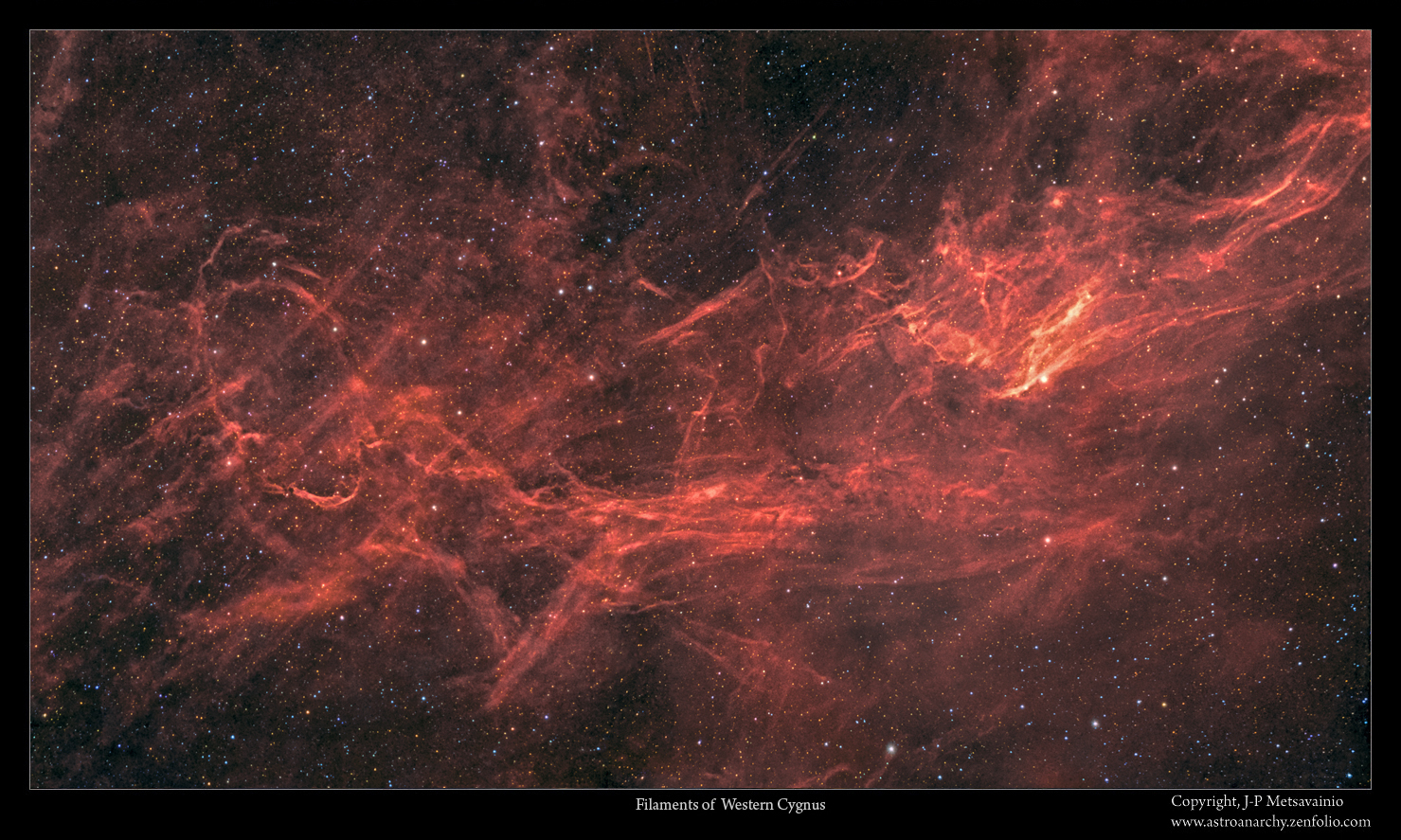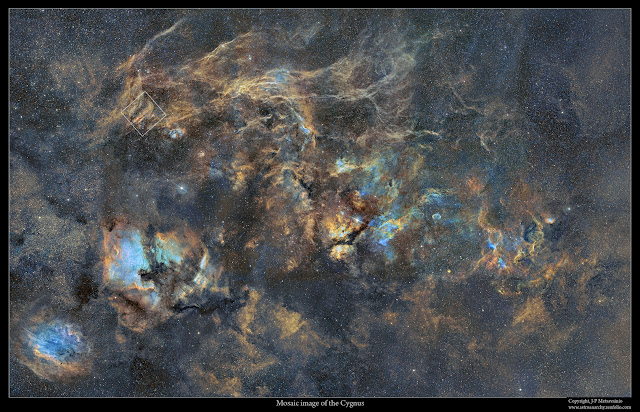COPYRIGHT, PLEASE NOTE
All the material on this website is copyrighted to J-P Metsavainio, if not otherwise stated. Any content on this website may not be reproduced without the author’s permission.
Have a visit in my portfolio
PORTFOLIO:https://astroanarchy.zenfolio.com/
Saturday, November 14, 2015
IC 1936, a closeup
I have spent most nights at this Autumn season by shooting dim targets around Cygnus.
At night of 2. November I shot few frames from a brighter target, IC 1396, in Cepheus. Just one hour of H-alpha light and one 20 min frame for O-III and S-II before clouds rolled in. Just got the data processed and the photo turned to be kind of nice, so I'm publishing it here. This is a second photo out of IC 1396 at this Autumn. The first one from the Elephant's Trunk Nebula can be seen HERE.
At night of 2. November I shot few frames from a brighter target, IC 1396, in Cepheus. Just one hour of H-alpha light and one 20 min frame for O-III and S-II before clouds rolled in. Just got the data processed and the photo turned to be kind of nice, so I'm publishing it here. This is a second photo out of IC 1396 at this Autumn. The first one from the Elephant's Trunk Nebula can be seen HERE.
IC 1396
Click for a large image
Natural color composition from the emission of ionized elements.
IC 1396 in mapped colors
Click for a large image
Image in mapped colors from the light emitted by ionized elements.
Red=Sulfur, Green=Hydrogen and Blue=Oxygen.
Orientation in IC 1396
Click for a large image
More info about this image can be seen HERE.
Orientation in constellation Cepheus
Click for a large image (3000 pixels wide)
A ten panel mosaic image of Cepheus, exposure time 92h. More info about this image can be seen HERE.
Technical details
Processing work flow
Image acquisition, MaxiDL v5.07.
Stacked and calibrated in CCDStack2.
Deconvolution with a CCDStack2 Positive Constraint, 21 iterations, added at 25% weight
Color combine in PS CS3
Levels and curves in PS CS3.
Imaging optics
Celestron Edge HD 1100 @ f7 with 0,7 focal reducer for Edge HD 1100 telescope
Mount
10-micron 1000
Cameras and filters
Imaging camera Apogee Alta U16 and Apogee seven slot filter wheel
Guider camera, Lodestar x2 and SXV-AOL
Astrodon filter, 5nm H-alpha
Astrodon filter, 3nm O-III
Astrodon filter, 3nm S-II
Exposure times
H-alpha, 3 x 1200s = 1h
O-III, 1 x 1200s binned = 20min.
S-II, 1 x 1200s = 20min.
Total 1h 40min.
Labels:
Narrowband color images,
nebula
Thursday, November 12, 2015
Filaments of Cygnus, a new processing for natural colors
As usually, I reprocessed the two frame mosaic of Cygnus filaments. The color balance and stars are better now and more details are visible. This area in Western Cygnus is rarely imaged since it has a low surface brightness and more attractive targets are nearby.
Cygnus filaments in visual spectrum
Click for a large image
This palette is very close to a visual spectrum. Image in mapped colors can be seen HERE
Click for a high resolution image
A large mosaic of "Cirrus of Cygnus" 2012. More info HERE
An area left from the center is seen in longer focal length photo above.
Even larger mosaic of the Cygnus
Click for a much large image
Info about this image HERE
Overlaid with a Cartes Du Ciel screenshot.
Technical details
Technical details can be seen in this blog post,
http://www.astroanarchy.blogspot.fi/2015/10/filaments-of-cygnus-project-continues.html
Labels:
Narrowband color images,
nebula
Tuesday, November 10, 2015
More filaments of Cygnus and couple of planetary nebulae
I just got this photo processed. It's showing an area near the Propeller Nebula, I noticed this dim planetary nebula candidate, PN PM 1-320, back in 2011 while I was shooting the Propeller Nebula with my 300mm Tokina lens. At the same image field there is another planetary nebula too, PK 84+9.1
Filaments of Cygnus with couple of planetary nebulae
Click for a large image
Image in mapped colors from the light emitted by ionized elements. Red=Sulfur,
Green=Hydrogen and Blue=Oxygen. A large blueish spot at middle left is a PN PM 1-320.
A small pale red dot at upper right is a planetary nebula PK 84+9.1
Green=Hydrogen and Blue=Oxygen. A large blueish spot at middle left is a PN PM 1-320.
A small pale red dot at upper right is a planetary nebula PK 84+9.1
Click for a large image
It looks to me, that the PN PM 1-320 forms a bubble shaped shock front in the interstellar gas.
Closeup of the PN PM 1-320
Closeup of the PK 84+9.1
Wide field image of the area
A pale bluish area at upper right is the PK 84+9.1 This image was taken at Autumn 2011, original blog post can be seen here: http://astroanarchy.blogspot.fi/2011/10/first-light-for-autumn-season-2011.html
Technical details
Processing work flow
Image acquisition, MaxiDL v5.07.
Stacked and calibrated in CCDStack2.
Deconvolution with a CCDStack2 Positive Constraint, 21 iterations, added at 25% weight
Color combine in PS CS3
Levels and curves in PS CS3.
Imaging optics
Celestron Edge HD 1100 @ f7 with 0,7 focal reducer for Edge HD 1100 telescope
Mount
10-micron 1000
Cameras and filters
Imaging camera Apogee Alta U16 and Apogee seven slot filter wheel
Guider camera, Lodestar x2 and SXV-AOL
Astrodon filter, 5nm H-alpha
Astrodon filter, 3nm O-III
Astrodon filter, 3nm S-II
Exposure times
H-alpha, 9x 1200s = 3h
O-III, 6 x 1200s binned = 2h
S-II, from an older wide field photo = 1h
Total 6h
Labels:
Narrowband color images,
nebula
Monday, November 9, 2015
Filaments of Cygnus
There are lots of dim gas filaments at west side of the Cygnus nebula complex. I have spent this Autumn season by shooting them. Due to close proximity of brighter and more eye catching nebulae in Cygnus, this area is not very commonly imaged.
Filaments of Cygnus
Click for a large imageNatural color composition from the emission of ionized elements.
Filaments of Cygnus in HST-mapped colors
Click for a large image
Image in mapped colors from the light emitted by ionized elements.
Red=Sulfur, Green=Hydrogen and Blue=Oxygen.
An experimental starless version
Click for a large imageAn experimental starless version
The actual nebula is easier to observe in this starless photo
A closeup
Interesting shapes in the nebula, they must be some kind of shock fronts
Orientation in the constellation Cygnus
Click for a large image
The area of interest is marked as a white rectangle in this 18-panels narrow band mosaic of the Cygnus.
Technical details
Processing work flow
Image acquisition, MaxiDL v5.07.
Stacked and calibrated in CCDStack2.
Deconvolution with a CCDStack2 Positive Constraint, 21 iterations, added at 25% weight
Color combine in PS CS3
Levels and curves in PS CS3.
Imaging optics
Celestron Edge HD 1100 @ f7 with 0,7 focal reducer for Edge HD 1100 telescope
Mount
10-micron 1000
Cameras and filters
Imaging camera Apogee Alta U16 and Apogee seven slot filter wheel
Guider camera, Lodestar x2 and SXV-AOL
Astrodon filter, 5nm H-alpha
Astrodon filter, 3nm O-III
Astrodon filter, 3nm S-II
Exposure times
H-alpha, 15 x 1200s = 5h.
O-III, 6 x 1200s binned = 2h
S-II, 6 x 1200s binned = 2h
Total 9h
Labels:
Narrowband color images,
nebula
Subscribe to:
Posts (Atom)



























